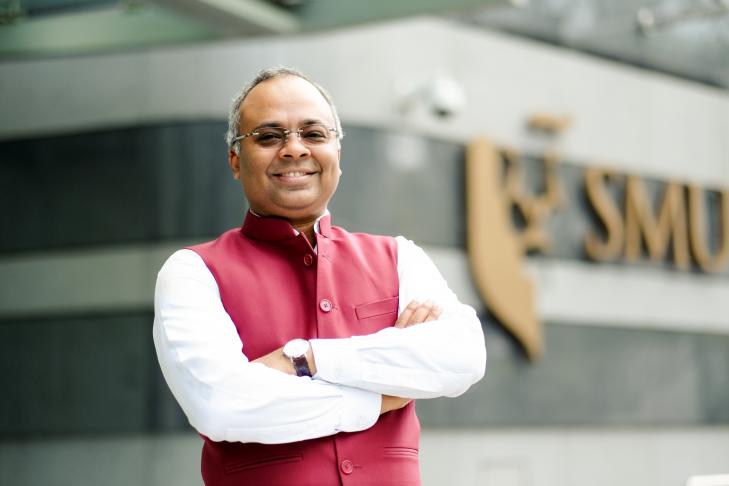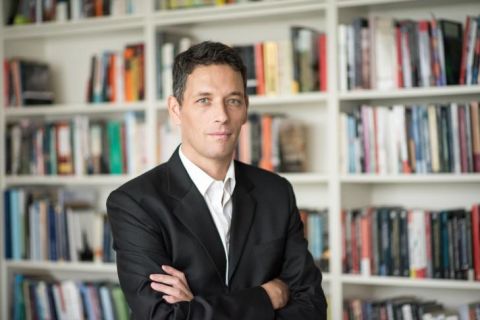
Conventional wisdom dictates that trade secrets have to be protected at all costs, but SMU Professor Gerard George’s research shows there may be a better way of doing business.

Photo Credit: Cyril Ng
By Feng Zengkun
SMU Office of Research – If tech firms of the world such as Amazon, Facebook and Google shared their technology secrets, the resulting innovation would undoubtedly be better for the world. But could such openness help the firms themselves as well?
Professor Gerard George, dean of the Singapore Management University (SMU) Lee Kong Chian School of Business, has developed numerous theories on why people collaborate with each other and how firms innovate and thrive, as part of a long career devoted to studying innovation and entrepreneurship.
His recent research paper, “Appropriability and the Retrieval of Knowledge After Spillovers”, co-authored with Imperial College London’s Assistant Professor Tufool Alnuaimi and published in Strategic Management Journal, upends the conventional wisdom that firms can only survive and grow by zealously guarding their work.
“Most research and development is built on the premise that technological secrecy is good and knowledge leakage is bad,” Professor George says. “But, sometimes, results get exposed through the patenting process or the innovation ecosystem. Firms that continue to invest in R&D could, in the long run, benefit from other firms’ innovations that use their original effort as a building block.”
Sharing and the freedom to innovate
In general, firms that produce more complicated technologies are more likely to benefit from part of their work becoming common knowledge, Professor George found. To understand why, consider the analogy of a jigsaw puzzle or Lego blocks.
“In low tech firms, there are only a few jigsaw pieces—each piece matters, and if you lose one to your rivals, that’s value loss. But in complex technologies, there are many interdependent pieces. If a rival builds on your work, you already have some of the pieces and can understand how to slot them to come up with the new puzzle, and even better ones. Your other rivals won’t have this advantage,” Professor George explains.
The technology’s complexity, however, is not the only factor. To reap the most benefit, the firms should give their employees some—but not too much—autonomy and freedom to experiment and innovate.
In a company that is too decentralised, the division that came up with the original product will find it difficult to obtain relevant knowledge from other divisions to build on rivals’ discoveries. If a firm’s departments are too interdependent, on the other hand, employees will find it difficult to understand exactly why projects succeeded or, more importantly, failed, hurting their ability to reverse-engineer and improve on competitors’ work.
“In Singapore, we tend to centralise a lot of functions, because we believe in efficient structures to cut costs and reduce duplicated efforts. But we have found that it is important not to be fully centralised but instead have some decoupling, especially in high-tech sectors. Having some autonomous units helps you to explore and absorb external knowledge for use,” he says.
The leaky innovation pipe
Each year, Cornell University, the United Nations’ World Intellectual Property Organisation and business school INSEAD publish a Global Innovation Index that ranks countries’ innovation investments and results, such as the numbers of patent applications, published scientific and technical articles, high-tech exports and science and engineering graduates.
While Singapore was ranked the most innovative country in Southeast Asia and Oceania in 2015, it was a shocking 100th in innovation efficiency, behind not only India, South Korea, Myanmar, Thailand and the Philippines, but also Zimbabwe and Nigeria. Simply put, Singapore, for all its investments into innovation, is not getting its bang for the buck.
“It’s very important for Singapore to improve its innovation productivity, so that companies feel that their investments in innovation will have a better pay-off in Singapore compared to other competing hubs in the region. If we don’t accomplish this, the consequences will erode the other advantages of being located in Singapore,” warns Professor George.
One way to improve innovation productivity is to develop better understanding on why people collaborate. In a study of relational capability and collaboration preferences, Professor George and his research team explores the attitudes toward collaboration in the UK’s plastics electronics industry.
According to the study, researchers are more likely to want to work with others when they believe they are ahead or behind of peers in their fields. Even when this professional gap exists, those with good networking and social skills are more likely to collaborate than their less sociable peers. And researchers in academia are, in general, more willing to collaborate than those in industry, especially on government-funded projects.
Relooking innovation from top to bottom
Collaboration has become indispensable for innovation, says Professor George, from different departments in a university working together to countries pooling their resources and expertise to solve problems such as climate change and advance scientific discovery. The Large Hadron Collider, the world’s single largest scientific machine, was built with the help of more than 10,000 scientists and engineers from more than 100 countries.
But to improve people’s lives, innovation needs to be successful at both the top and bottom of the social pyramid, Professor George reckons. As he puts it, “At the top, we need to improve organisations’ innovation and investments in technologies, so they can create more value for society. At the bottom, we need to look at improving business and distribution models so that the innovations can actually transform lives on the ground.”
See More News
Want to see more of SMU Research?
Sign up for Research@SMU e-newslettter to know more about our research and research-related events!
If you would like to remove yourself from all our mailing list, please visit https://eservices.smu.edu.sg/internet/DNC/Default.aspx

